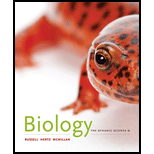
Introduction:
Immune system is the defense system of an organism which consists of various biological processes and structures that provide protection against various pathogens. The immune system must be able to identify variety of pathogenic microbes and to differentiate them from the host’s cells.
Answer to Problem 1TYK
Correct answer:
The three lines of defenses i.e. physical barrier, innate immune system and adaptive immune system, work independently of each other in defending against a particular pathogen.
Explanation of Solution
Justification for the correct answer:
Option (a) states that ‘the three lines of defense work independently of each other in defending against a particular pathogen’. This is a true statement as each organism, which is exposed to the disease causing viruses and organisms, consists of three lines of defense against these threats. First line is physical barriers like skin, second line is innate immune system and third line of defense includes adaptive immune system. Notably, these three host defense lines take cumulative actions to defend the host against pathogenic microbes. Hence, option (a) is correct.
Justification for the incorrect answers:
Option (b) states that ‘physical barriers are part of the immune system. This statement is not true as physical barriers are not a part of immune system. The mammalian immune system of an organism is made up of innate and adaptive immunity. So, it is an incorrect option.
Option (c) states that ‘the adaptive immune system reacts faster to pathogens than the innate immune system. This is false as the innate immune responses are the first one to act when the host’s body is attacked by pathogenic microbes, whereas adaptive immunity takes several days to become protective. So, it is an incorrect option.
Option (d) states that ‘once the adaptive immune system is activated in response to a specific pathogen, the innate immune system stops functioning against that specific pathogen’. This is an incorrect statement because the innate and adaptive immunity take cumulative action against pathogens. So, it is an incorrect option.
Option (e) states that ‘white blood cells are the key participants in adaptive immunity but not in innate immunity’. This is an incorrect statement as the white blood cells are part of both innate and adaptive immune response. So, it is an incorrect option.
Hence, options (b), (c), (d) and (e) are incorrect.
Thus, it can be concluded that host defense system prevents the invasion of pathogens by the three lines of defenses i.e. physical barrier, innate immune system and adaptive immune system.
Want to see more full solutions like this?
Chapter 45 Solutions
Biology: The Dynamic Science (MindTap Course List)
- How is a protein destined for the Endoplasmic Reticulum (ER), imported into the ER? Be concise.arrow_forwardFind out about the organisations and the movements aimed at the conservation of our natural resources. Eg Chipko movement and Greenpeace. Make a project report on such an organisation.arrow_forwardWhat are biofertilizers and mention the significancearrow_forward
- PCBs and River Otters: Otters in Washington State’s Green-Duwamish River have high levels of polychlorinated biphenyls (PCBs) in their livers. PCBs can bind to the estrogen receptors in animals and disrupt the endocrine system of these otters. The PCBs seem to increase the estrogen to androgen ratio, skewing the ratio toward too much estrogen. How would increased estrogen affect the river otter population? Based on your reading of the materials in this unit, what factors can affect fertility in humans? Explain how each of the factors affecting human fertility that you described can disrupt the human endocrine system to affect reproduction.arrow_forwardOther than oil and alcohol, are there other liquids you could compare to water (that are liquid at room temperature)? How is water unique compared to these other liquids? What follow-up experiment would you like to do, and how would you relate it to your life?arrow_forwardSelection of Traits What adaptations do scavengers have for locating and feeding on prey? What adaptations do predators have for capturing and consuming prey?arrow_forward
- Competition Between Species What natural processes limit populations from growing too large? What are some resources organisms can compete over in their natural habitat?arrow_forwardSpecies Interactions Explain how predators, prey and scavengers interact. Explain whether predators and scavengers are necessary or beneficial for an ecosystem.arrow_forwardmagine that you are conducting research on fruit type and seed dispersal. You submitted a paper to a peer-reviewed journal that addresses the factors that impact fruit type and seed dispersal mechanisms in plants of Central America. The editor of the journal communicates that your paper may be published if you make ‘minor revisions’ to the document. Describe two characteristics that you would expect in seeds that are dispersed by the wind. Contrast this with what you would expect for seeds that are gathered, buried or eaten by animals, and explain why they are different. (Editor’s note: Providing this information in your discussion will help readers to consider the significance of the research).arrow_forward
 Biology: The Dynamic Science (MindTap Course List)BiologyISBN:9781305389892Author:Peter J. Russell, Paul E. Hertz, Beverly McMillanPublisher:Cengage Learning
Biology: The Dynamic Science (MindTap Course List)BiologyISBN:9781305389892Author:Peter J. Russell, Paul E. Hertz, Beverly McMillanPublisher:Cengage Learning
 Biology 2eBiologyISBN:9781947172517Author:Matthew Douglas, Jung Choi, Mary Ann ClarkPublisher:OpenStax
Biology 2eBiologyISBN:9781947172517Author:Matthew Douglas, Jung Choi, Mary Ann ClarkPublisher:OpenStax Human Biology (MindTap Course List)BiologyISBN:9781305112100Author:Cecie Starr, Beverly McMillanPublisher:Cengage Learning
Human Biology (MindTap Course List)BiologyISBN:9781305112100Author:Cecie Starr, Beverly McMillanPublisher:Cengage Learning Medical Terminology for Health Professions, Spira...Health & NutritionISBN:9781305634350Author:Ann Ehrlich, Carol L. Schroeder, Laura Ehrlich, Katrina A. SchroederPublisher:Cengage Learning
Medical Terminology for Health Professions, Spira...Health & NutritionISBN:9781305634350Author:Ann Ehrlich, Carol L. Schroeder, Laura Ehrlich, Katrina A. SchroederPublisher:Cengage Learning Human Heredity: Principles and Issues (MindTap Co...BiologyISBN:9781305251052Author:Michael CummingsPublisher:Cengage Learning
Human Heredity: Principles and Issues (MindTap Co...BiologyISBN:9781305251052Author:Michael CummingsPublisher:Cengage Learning





